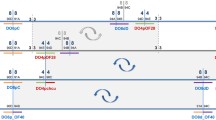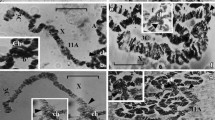Abstract
Position-effect variegation in Drosophila melanogaster is accompanied by compaction of the corresponding chromosomal regions. The compaction can be continuous, so that bands and interbands located distal to the eu-heterochromatic junction fuse into one dense block, or discontinuous, when two or more zones of compaction are separated by morphologically and functionally normal regions. In this work it was found that in both continuous and discontinuous compaction the blocks of dense material contain the immunochemically detectable protein HP1, which has previously been characterized as specific for heterochromatin. The regions undergoing compaction do not contain HP1 when they have a normal banding pattern. Thus, it may be proposed that HP1 is one of the factors involved in compaction. If two different or two identical rearrangements are combined in the same nucleus, they variegate independently. The frequency of compaction of the two rearrangements in the same nucleus corresponds to the product of the frequencies of the compact state of the individual elements. The extent of compaction (i.e. the number of bands involved in heterochromatization) of each rearrangement does not depend on the compaction pattern of the other rearranged element.
Similar content being viewed by others
References
Belyaeva ES, Zhimulev IF (1991) Cytogenetical and molecular aspects of position effect variegation in Drosophila melanogaster. III. Continuous and discontinuous compaction of chromosomal material as a result of position effect variegation. Chromosoma 100: 453–466
Brunström O (1955) Maternal influence on variegation in the M-5 chromosome. Dros Inf Serv 29: 108
Eissenberg JC, James TC, Foster-Hartnett DM, Hartnett T, Ngan V, Elgin SCR (1990) Mutation in a heterochromatin-specific chromosomal protein is associated with suppression of position effect variegation in Drosophila melanogaster. Proc Natl Acad Sci USA 87: 9923–9927
Gartler SM, Riggs AD (1983) Mammalian X chromosome inactivation. Annu Rev Genet 17: 155–190
Hartmann-Goldstein IJ (1967) On the relationship between heterochromatization and variegation in Drosophila, with special reference to temperature-sensitive periods. Genetics 10: 143–159
Hartmann-Goldstein IJ, Wargent JM (1975) Cytological observations on the interaction between two inversions responsible for position effect variegation in Drosophila melanogaster. Chromosoma 52: 349–362
Hayashi S, Ruddel A, Sinclaird D, Grigliatti T (1990) Chromosomal structure is altered by mutations that suppress or enhance position effect variegation. Chromosoma 99: 391–400
James TC, Eissenberg JC, Craig C, Dietrich V, Hobson A, Elgin SCR (1989) Distribution pattern of HP1, a heterochromatin-associated nonhistone chromosomal protein of Drosophila. Eur J Cell Biol 50: 170–180
Lewis EB (1950) The phenomenon of position effect. Adv Genet 3: 73–115
Lindsley DL, Zimm GG (1992) The genome of Drosophila melanogaster. Academic Press, San Diego New York Boston London Sydney Tokyo Toronto
Ohno S (1990) Grammatical analysis of DNA sequences provided a rationale for the regulatory control of an entire chromosome. Genet Res 56: 115–120
Reuter G, Werner W, Hoffmann HJ (1982) Mutations affecting position effect heterochromatization in Drosophila. Chromosoma 85: 539–551
Schultz J (1941) The functions of heterochromatin. Proc 7th Int Congr Genet [Suppl]: 257–262
Smirnov NV, Dunin-Barkovsky NV (1969) Theory of probabilities and mathematical statistics for technical purposes, Nauka, Moscow
Spofford JB (1976) Position-effect variegation in Drosophila. In: Ashburner M, Novitski E (eds) The genetics and biology of Drosophila, vol. 1c Academic Press, London New York San Francisco, pp 955–1018
Tartof KD, Bremer M (1990) Mechanisms for the construction and developmental control of heterochromatin formation and imprinted chromosome domains. Development [Suppl]: 35–45
Tartof KD, Hobbs C, Jones M (1984) A structural basis for variegation position effect. Cell 37: 869–878
Umbetova GH, Belyaeva ES, Baricheva EM, Zhimulev IF (1991) Cytogenetic and molecular aspects of position effect variegation in Drosophila melanogaster. IV. Underreplication of chromosomal material as a result of gene inactivation. Chromosoma 101: 55–61
Vlassova IE, Graphodatsky AS, Belyaeva ES, Zhimulev IF (1991) Constitutive heterochromatin in early embryogenesis of Drosophila melanogaster. Mol Gen Genet 229:316–318
Zhimulev IF (1974) Comparative study of the function of polytene chromosomes in laboratory stocks of Drosophila melanogaster and the l(3)tl (lethal tumorous larvae). I. Analysis of puffing pattern in autosomes of the laboratory stock Batumi-L. Chromosoma 46:59–76
Zhimulev IF, Belyaeva ES, Fomina OV, Protopopov MO, Bolshakov VN (1986) Cytogenetical and molecular analysis of position effect variegation in Drosophila melanogaster. II Morphology and genetic activity of the 2AB region in chromosome rearrangement T(1; 2)dorvar7. Chromosoma 100: 453–466
Zhimulev IF Belyaeva ES, Bgatov AV, Baricheva EM, Vlassova IE (1988) Cytogenetical and molecular analysis of position effect variegation in Drosophila melanogaster. III. Peculiarities of morphology and genetic activity of the 2B region in the T(1 ;2)dorvar7 chromosome in males. Chromosoma 96: 255–261
Zhimlev IF, Belyaeva ES, Bolshakov VN, Mal'ceva NI (1989) Position effect variegation and intercalary heterochromatin: a comparative study. Chromosoma 98: 378–387
Zuckerkandl E (1974) A possible role of “inert” heterochromatin in cell differentiation. Action and competition for locking molecules. Biochemie 56: 937–954
Zuckerkandl E, Villet R (1988) Generation of high specificity binding of proteins to DNA. FEBS Lett 231: 291–298
Author information
Authors and Affiliations
Additional information
Communicated by: A. Spradling
Rights and permissions
About this article
Cite this article
Belyaeva, E.S., Demakova, O.V., Umbetova, G.H. et al. Cytogenetic and molecular aspects of position-effect variegation in Drosophila melanogaster . Chromosoma 102, 583–590 (1993). https://doi.org/10.1007/BF00368351
Received:
Revised:
Accepted:
Issue Date:
DOI: https://doi.org/10.1007/BF00368351




